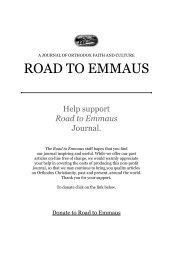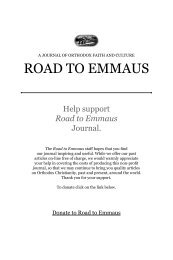RTE No 20 Interior - Road to Emmaus Journal
RTE No 20 Interior - Road to Emmaus Journal
RTE No 20 Interior - Road to Emmaus Journal
Create successful ePaper yourself
Turn your PDF publications into a flip-book with our unique Google optimized e-Paper software.
<strong>Road</strong> <strong>to</strong> <strong>Emmaus</strong> Vol. VI, <strong>No</strong>. 1 (#<strong>20</strong>)The Christian AfterlifeAccording <strong>to</strong> the Church fathers, the afterlife we experience after deathbut before the Last Judgement differs from the ancient Greek idea ofHades, where the soul has no volition, no fullness of life. This is not theChristian notion of the afterlife! The life of the soul after death is in onesense a continuation of its life on earth, with its acquired passions andvirtues. If death radically changed the nature of the soul, this would violatethe soul’s freedom. However, according <strong>to</strong> the fathers, after death the powersof the soul are restricted. It can no longer repair its evil deeds on earth(alas!), or initiate a good action by its own will, but it can pray, asking Christfor forgiveness and help for itself and others.Orthodox Church tradition most commonly teaches that after the soulleaves the body, the souls of both the righteous and the sinners are in a stateof waiting for the Last Judgement when they will be reunited with their transfiguredbodies. There are exceptions, such as the Theo<strong>to</strong>kos, the Mother ofGod, who was borne body and soul by the angels directly in<strong>to</strong> heaven. As formost of us, they say, we remain in this condition of waiting until the LastJudgement. Those who have lived their present life with virtue and werepleasing <strong>to</strong> God, are anchored after death in the “bosom of Abraham,” that is,in a spiritual place of blessedness. The impious will be in a worse place. St.Athanasius teaches that after death the righteous experience a “partial enjoyment,”while the sinners experience a “partial judgement.”<strong>RTE</strong>: And when and how did the teaching on the <strong>to</strong>ll houses arise?IRINA: If we are <strong>to</strong> discuss the <strong>to</strong>ll houses, we first have <strong>to</strong> clarify that this traditionis not a dogma of the Orthodox Church, nor an official teaching, but arecurring idea in Orthodox tradition. St. Cyril of Alexandria gives one of ourearliest references <strong>to</strong> ordeals at the <strong>to</strong>ll houses, through which the soul passesascending <strong>to</strong> the throne of God, but this tradition began <strong>to</strong> flourish onlyafter the popularization of the Ordeals of the Blessed Theodora. This was nota text in its own right, but a famous passage from the tenth-century Life ofBasil the Younger (a Byzantine saint of Constantinople who reposed in 944)on the vision granted <strong>to</strong> Basil’s disciple, Gregory, about the fate of Basil’s formermaid, Theodora, after her death. She revealed her fate <strong>to</strong> him in a dreamand he wrote her s<strong>to</strong>ry down. The idea developed that the soul after its deathabandons the body and passes through <strong>to</strong>ll-houses where it is questioned by32The Good Shephard, 1773, St. John the Theologian Monastery, Patmos.










